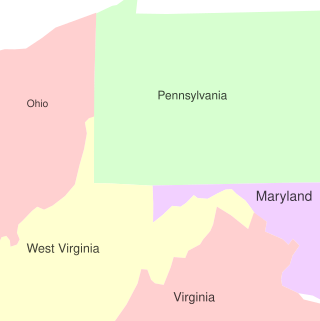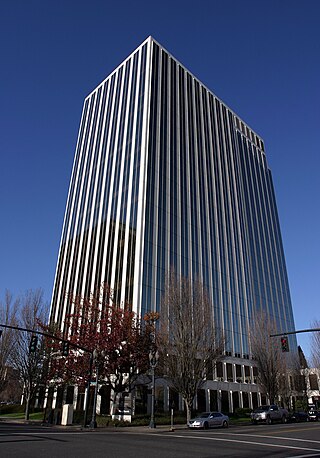Progress Energy, headquartered in Raleigh, North Carolina, is a subsidiary of Duke Energy and prior to its merger with Duke Energy was a Fortune 500 energy company with more than 21,000 megawatts of generation capacity and $9 billion in annual revenues. Progress Energy includes two major electric utilities that serve approximately 3.1 million customers in the Carolinas and Florida. As an independent company, the last chairman and CEO of Progress Energy was William D. Johnson; his predecessor was Robert McGehee, who died on October 9, 2007, at the age of 64 of a stroke while on a business trip to London.
Fortis Inc. is a St. John's, Newfoundland and Labrador-based international diversified electric utility holding company. It operates in Canada, the United States, Central America, and the Caribbean. In 2015, it earned CA$6.7 billion.

FirstEnergy Corp. is an electric utility headquartered in Akron, Ohio. It was established when Ohio Edison merged with Centerior Energy in 1997. Its subsidiaries and affiliates are involved in the distribution, transmission, and generation of electricity, as well as energy management and other energy-related services. Its ten electric utility operating companies comprise one of the United States' largest investor-owned utilities, based on serving 6 million customers within a 65,000-square-mile (170,000 km2) area of Ohio, Pennsylvania, West Virginia, Virginia, Maryland, New Jersey, and New York. Its generation subsidiaries control more than 16,000 megawatts of capacity, and its distribution lines span over 194,000 miles. In 2018, FirstEnergy ranked 219 on the Fortune 500 list of the largest public corporations in the United States by revenue.

Allegheny Energy was an electric utility headquartered in Greensburg, Pennsylvania. It owned and operated electric generation facilities and delivered electric services to customers in Pennsylvania, West Virginia, Maryland, and Virginia. Allegheny Energy was incorporated in Maryland in 1925 as West Penn Electric Company. One of its predecessor companies dates back to the formation of West Penn Power on January 31, 1907.

WEC Energy Group is an American company based in Milwaukee, Wisconsin that provides electricity and natural gas to 4.4 million customers across four states.
Centel Corporation was an American telecommunications company, with primary interests in providing basic telephone service, cellular phone service and cable television service.

PacifiCorp is an electric power company in the western United States.

Kansas City Power and Light Company was an electric utility company serving the Kansas City metropolitan area. It was a wholly owned subsidiary of Great Plains Energy of which it was the biggest component. The company traces its roots to November 1881 when Joseph S. Chick obtained the exclusive rights to use the Thompson-Houston arc lighting system in the counties of Jackson, Missouri, and Wyandotte, Kansas, for $4,000. The following month, the initial franchise to establish an electric works in the City of Kansas, Mo., was granted to Lysander R. Moore and later assigned to Kawsmouth Electric Light Company. Construction was begun in February 1882 on a power plant on a tract of land at the southeast corner of 8th and Santa Fe Streets in the West Bottoms. Kawsmouth Electric Light Company built quickly and, on Saturday night, May 13, 1882, brought electric illumination to the first 13 customers on the west side of Main Street in the downtown district. In 1885 the company reincorporated as Kansas City Electric Light Company.

Great Plains Energy Incorporated was a holding company based in Kansas City, Missouri that owned electric utility Kansas City Power and Light Company and Strategic Energy, LLC, an energy management company.
Quanta Services is an American corporation that provides infrastructure services for electric power, pipeline, industrial and communications industries. Capabilities include the planning, design, installation, program management, maintenance and repair of most types of network infrastructure. In June 2009, Quanta Services was added to the S&P 500 index, replacing Ingersoll-Rand.
Evergy, Inc. is an American investor-owned utility (IOU) with publicly traded stock with headquarters in Topeka, Kansas, and in Kansas City, Missouri. The company was formed from a merger of Westar Energy of Topeka and Great Plains Energy of Kansas City, parent company of Kansas City Power & Light. Evergy is the largest electric company in Kansas, serving more than 1.7 million residential, commercial and industrial customers in Kansas and Missouri. Its more than 40 power plants have generating capacity of 16,000 megawatt electricity in Kansas and Missouri. Service territory covers 28,130 square miles (72,900 km2) in east Kansas and west Missouri. It owns more than 10,100 miles (16,300 km) of transmission lines and about 52,000 miles (84,000 km) of distribution lines.

Black Hills Corporation is a Rapid City, South Dakota diversified energy company that is an electric and gas utility in South Dakota, Montana, Wyoming, Colorado, Arkansas, Kansas, Nebraska, and Iowa. The company sells power throughout the American West.
MDU Resources Group, Inc. is a U.S.-based corporation supplying products and services to regulated energy delivery and utilities related construction materials and services businesses. It is headquartered in Bismarck, North Dakota, and operates in 48 states.
This is a list of Electricity distribution companies by country.
Missouri Gas Energy (MGE) was a natural gas distribution company headquartered in Kansas City, Missouri in the United States, with offices in St. Joseph, Lee's Summit, Warrensburg, Joplin, Republic, Neosho and Monett. MGE served over in 155 western Missouri communities and was a division of the Southern Union Company until it was ultimately sold to the Spire Inc. Its business is regulated by the Missouri Public Service Commission.
Algonquin Power & Utilities Corp. is a Canadian renewable energy and regulated utility conglomerate with assets across North America. Algonquin actively invests in hydroelectric, wind and solar power facilities, and utility businesses, through its three operating subsidiaries: Bermuda Electric Light Company, Liberty Power and Liberty Utilities.
Abram Edward Fitkin was an American minister, investment banker, businessman, public utilities operator, and philanthropist, who founded and ran dozens of companies, including A.E. Fitkin & Co.; the National Public Service Corporation; the United States Engineering Corporation; and the General Engineering and Management Corporation, which by 1926 managed 178 utility companies in 18 US states and over 1,000 local communities. As a philanthropist Fitkin donated in excess of $3,000,000 to finance the construction of the Raleigh Fitkin Memorial Hospital in Manzini, Swaziland; the Raleigh Fitkin Memorial Institution in Scobeyville, New Jersey; the Raleigh Fitkin Memorial Pavilion for Children at the New Haven Hospital in Yale; and the Jersey Shore University Medical Center at Neptune Township, New Jersey.

The Electric Bond and Share Company (Ebasco) was a United States electric utility holding company organized by General Electric. It was forced to divest its holding companies and reorganize due to the passage of the Public Utility Holding Company Act of 1935. Following the passage of the Act, the U.S. Securities and Exchange Commission (SEC) selected the largest of the U.S. holding companies, Ebasco to be the test case of the law before the U.S. Supreme Court. The court case known as Securities and Exchange Commission v. Electric Bond and Share company was settled in favor of the SEC on March 28, 1938. It took twenty-five years of legal action by the SEC to break up Ebasco and the other major U.S. electric holding companies until they conformed with the 1935 act. It was allowed to retain control of its foreign electric power holding company known as the American & Foreign Power Company (A&FP). After its reorganization, it became an investment company, but soon turned into a major designer and engineer of both fossil fuel and nuclear power electric generation facilities. Its involvement in the 1983 financial collapse of the Washington Public Power Supply System's five nuclear reactors led to Ebasco's demise because of the suspension of nuclear power orders and lawsuits that included numerous asbestos claims. The U.S. nuclear industry stopped all construction of new facilities following the 1979 nuclear meltdown at Three Mile Island, going into decline because of radiation safety concerns and major construction cost overruns.








